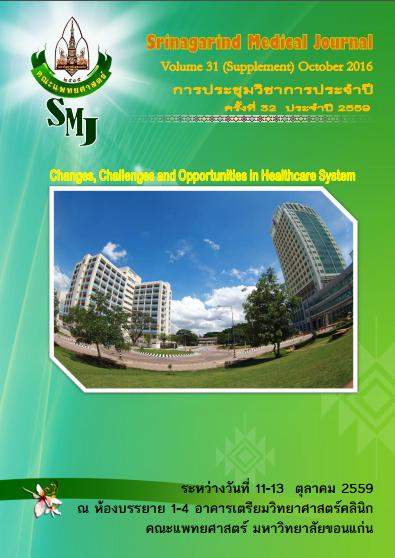The Effect of CytidineDeaminase Polymorphisms on Hematotoxicity in Thai Cancer Patients Treated with Gemcitabine-based Chemotherapy
Keywords:
cytidinedeaminase, CDA polymorphisms, gemcitabine, hematotoxicityAbstract
Background and Objective: Gemcitabine (dFdC) is a high efficacy chemotherapy that used in pancreatic cancer, non-small cell lung cancer (NSCLC), ovarian cancer, bladder cancer and cholangiocarcinoma patients.However, clinical outcome and adverse effect depend on variation of gemcitabine pharmacokinetics. However, 90% of gemcitabine metabolized to inactive form by cytidinedeaminase enzyme (CDA). Patients who carriedCDA*2 and CDA+435C>Thave high CDA activity and decrease risk of hematotoxicity.Previous report showed patients who carried CDA1/*2 and *2/*2 mutant allele decrease risk of neutropenia and thrombocytopenia from gemcitabine more than wildtype group (*1/*1). Moreover,NSCLC patients who carried CDA+435 CT or TTgenotype have lower gemcitabine response rate than wild type. This study aimed to determine correlation between CDA polymorphisms and hematotoxicity in Thai cancer patients who treated with gemcitabine-based chemotherapy.
Methods: Seventy patients who treated with gemcitabine-based chemotherapy were enrolled in this study. CDA genotype analysis was performed by Real-time PCR technique with specific TaqMan® probe. Severity ofhematotoxicitywas evaluated by National Cancer Institute Common Toxicity Criteria (CTCAE) version 4.0 guideline. Severity ofhematotoxicity was determined during the first 3 months after treatment. Correlation between CDA polymorphism and hematotoxicity were assessed by Binary Logistic regression test in SPSS statistic software version 17.0 (SPSS Inc., Chicago, USA)
Results: Patients who carried CDA*1/*2 and CDA + 435CT/TTpolymorphisms tended to decrease risk of neutropenia. However,correlation between CDApolymorphisms and hematotoxicity not statistically significant.
Conclusion: CDA*1/*2andCDA + 435CT/TT SNP tended to decrease risk of hematotoxicity but no statisticsignificant because of small sample size.




